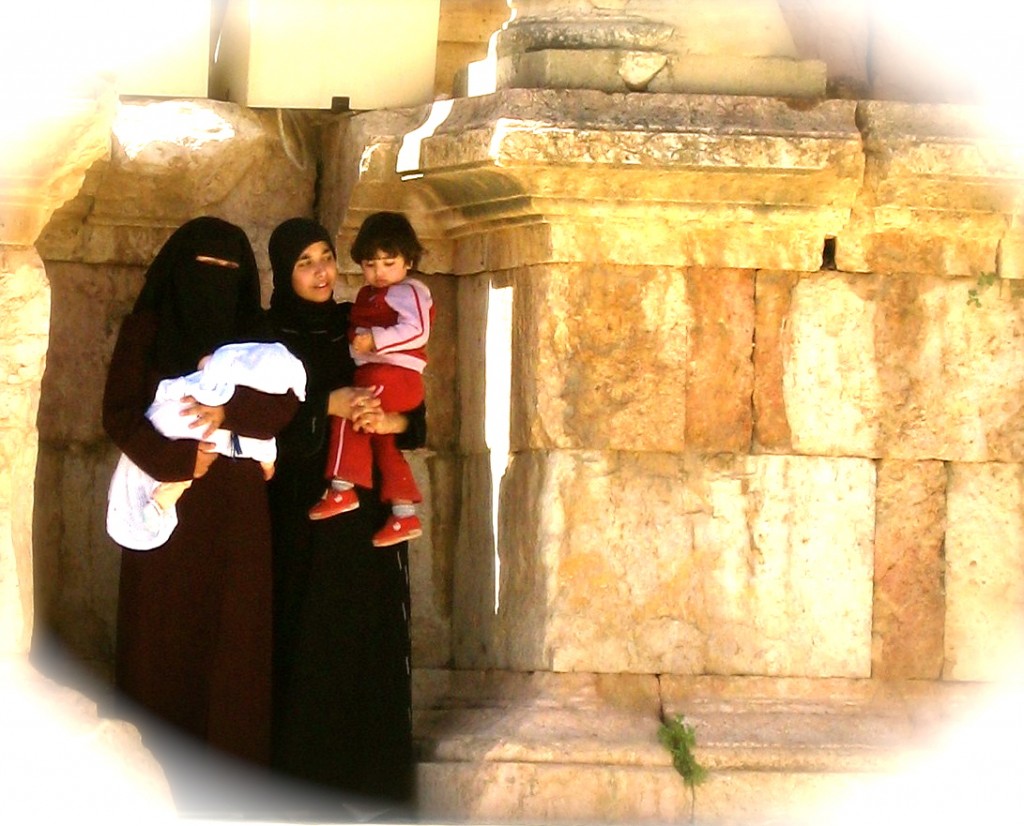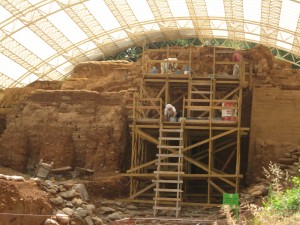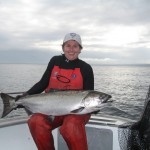Month: May 2013
Armchair archaeology: what a concept! I discovered last week a new technology poised to enable a person to make vicarious archaeological discoveries. Here’s the article link: http://fxn.ws/ZNOKry
 Two links embedded therein are quite cool: http://giza3d.3ds.com/#discover (a 3D exploration of the Giza pyramids as they looked thousands of years ago) and http://paris.3ds.com/en-index.html#Heritage (a 3D Parisian stroll spanning centuries).
Two links embedded therein are quite cool: http://giza3d.3ds.com/#discover (a 3D exploration of the Giza pyramids as they looked thousands of years ago) and http://paris.3ds.com/en-index.html#Heritage (a 3D Parisian stroll spanning centuries).
Sitting in my jammies, peering at my screen, sipping iced tea would be a LOT more comfortable than expiring in 118-degree June heat (almost 48 degrees Celsius) on the shores of Galilee, ferreting as an amateur in a pile of dusty debris to unearth obscure clay chunks. As a matter of fact, I can’t imagine a more enjoyable way to discover anything.

Archaeology is dirty, back-breaking, unglamorous work. (Kind of like writing.) It requires specialized knowledge of history, the patience of Job, and gallons of sunblock. Hands resembling claws, hair mimicking a broom, and skin of camel leather mark most professional archaeologist I’ve seen. In short, there’s nothing comfortable about the profession, nor is it easy. (Kind of like writing.) And the chances of a Howard-Carteresque-Tutankhamen discovery are one in a zillion. (Kind of like writing.)
Here in my office now, I have pottery dating from 11th- and 12th-century Persia, and 17th-century France. A Coptic manuscript page, and illustrated Byzantine ones. A (miraculously intact) 6th-century terracotta flask, and a 3rd-century Roman glass bottle. I can identify these items as easily as I can spot fluid syntax or a pronoun error. These skills have taken decades to develop, honing a weird, subconscious intuition. Could I have developed these off-site, or without laborious practical experience?
I’m excited about what the future holds, and actively watch developments in archaeology that ease, fine-tune, and speed the discovery process. These technologies offer great promise, like the social-media-management apps cited in last week’s blog (http://bit.ly/15yuiiG) that ease, fine-tune, and speed platform-building.
But what I’m really looking for is something to streamline the publishing process. Hope springs eternal.
(Shakespeare is turning in his grave, but he’s been loosely quoted before. And be warned this is an opinionated post.)
 I tweeted today (http://aje.me/ZzCsCn) about Yemeni women struggling with tradition versus rights. Then I remembered my generation hasn’t been without evolution, so reminded myself not to take a Western, superior attitude toward struggling Middle-Eastern sisters.
I tweeted today (http://aje.me/ZzCsCn) about Yemeni women struggling with tradition versus rights. Then I remembered my generation hasn’t been without evolution, so reminded myself not to take a Western, superior attitude toward struggling Middle-Eastern sisters.
I was fortunate to be a teen of the 70’s—great music, greater prosperity—and probably am one of few who remember the decade clearly. ( I didn’t “drink the Kool-Aid.”) Growing up in a conservative Christian denomination, I knew ONE female college professor, ONE piano teacher, and ONE nurse. Everyone else was a wife and/or mother—exclusively. Professional role models were scarce as after-service smokers on the church’s front porch. (Wait—there were actually more smokers.)
Gloria Steinem and Bella Abzug were revelations; a career AND husband AND children were epiphanies. The glass ceiling (anyone remember that?) beckoned, glistening just out of reach until I crashed through it with enough momentum (good thing I have a hard head) its shards could fill the Milky Way.
What happened? America became prosperous. Our culture stigmatized “working mothers.” Many quit their jobs the moment a husband made enough money to support the family, dedicating themselves to tennis, Junior League, or helicoptering kids.
What did we teach our daughters in the process?
My children attended a swanky college-preparatory school with classmates whose family’s names are recognized globally. A lot of privilege, money, heritage and entitlement flooded those waxed hallways. But you know what’s interesting? Of my son’s graduating class, all but one of the top ten students had working mothers. And my daughter’s class mimicked the ratio. Coincidence?
I believe their generation (particularly girls) learned work ethics from moms. Dads were at the office, or largely somewhere else, unobserved. But if Mom was home—if they saw her struggle to balance work and parenting, if they bore the condescendion of her being unable to work the school lunch line because she was making money—they developed priorities to sustain and propel them through rough adult years ahead. She was a scrappy role model for adult life both in and out of the home.
Some Western women are little more than privileged burka-wearers. And I’m still picking glass from my hair.[subscribe2]
In the past weeks, I’ve blogged about how overwhelming social-media (SM) can be. Build a platform; get your name out there; attract a following. As if writing isn’t time-consuming enough, there’s marketing to do. (F. Scott Fitzgerald partied; Hemingway fished; Joyce…well, never mind; I tweet. Something’s wrong with this picture.)
I use two tools to simplify my social media management, and am adding a third to writing management this month. Other tools exist, and I’d recommend investing a few hours to discover what will help you contain your SM animal. Then go write!
BITLY—This website shrinks a twitter-limit-busting link to the point I can actually say a few words about its content, with a couple of spaces left for it to be retweeted. https://bitly.com/shorten/

BUFFER—I just returned from a weekend with four octogenarians, my daughter-in-law (graduating law-school valedictorian) and son (graduating in the top ten in August—he “married up”). They are infinitely more important than my very-important writing endeavor. By parking tweets in buffer (you link a twitter and/or facebook account each time you log in), I didn’t think about losing momentum during a champagne toast. Buffer may be the single most important tool I’m using for SM. (It can be used with facebook, but I prefer facebook posts more in-the-moment, tailored to that particular medium with photos and such.) https://bufferapp.com/
SCRIVENER—This writing-management tool should be included. It organizes your thoughts and ideas for your manuscript, making a kind of electronic file so you can stay organized and retain threads and research that wander off (probably in search of chocolate and bandages if editing—see http://blog.nlbhorton.com/?p=498). I’m just beginning to learn how to use it, but think it’s going to work spectacularly well, and will eliminate the time I spend chasing down oddities I want to include, but can’t quite remember where I put them. http://www.literatureandlatte.com/scrivener.php
FACEBOOK’S DELAYED POSTS—Facebook enables an account to write a post, then schedule it for publication later. In the professional facebook page, click the clock icon in the bottom left corner, then add the date and time you want the post to appear. Even during the SECOND champagne toast, I didn’t think about SM because I scheduled a facebook post with photo for every day I was away. Regardless of my location, facebook and twitter carried on.
And of course, you can schedule WordPress blog posts to publish anytime—even now, as I sitting in my hermitage office, looking up a mountain valley, resuming the publishing fight.
I’m interested in any tricks of the SM trade you’ve discovered. Care to share?[subscribe2]
 I’m going back. Next March, after a too-short stop in Rome for manuscript two, I’ll be in Israel again for several weeks. Although manuscript one, partially set in Israel and Jordan, is complete, I need a larger photographic record for promotions. (That’s the official reason for the trip, anyway.)
I’m going back. Next March, after a too-short stop in Rome for manuscript two, I’ll be in Israel again for several weeks. Although manuscript one, partially set in Israel and Jordan, is complete, I need a larger photographic record for promotions. (That’s the official reason for the trip, anyway.)
The real reason is I knew I’d return the moment our plane’s wheels last left the tarmac at Ben Gurion Airport in Tel Aviv. It happens every time.
It’s been too long since I’ve marveled at Jerusalem’s ancient, pale limestone steps worn several inches shallow in the center by millions of footsteps over millennia. Stood atop the staircase at the end of Bab el-Silsileh Road gawking across the plaza at the Temple Mount, Al-Aqsa Mosque’s gold dome seizing my breath. Peered at the stump of Robinson’s Arch protruding from the southern Mount wall, and imagined the stoa (covered walkway connecting the city to the Mount in Herod’s time) once leaping from there. Worked the Mazar dig near Hezekiah’s Tunnel and the Silwan. I remember every spot clearly and precisely.
But the trip isn’t just about Jerusalem. Ceasarea, with wonderful submerged ruins, and Megiddo, where nations will gather at Armageddon, are on the docket. The Cliffs of Arbel, which I bravely (and loudly) descended above the Sea of Galilee; Jericho, which my heroine and her daughter diss en route under duress; and excavations in northern Israel, figuring in manuscript one. 
Masada, which I’ll ascend in a cable car, instead of reliving the cardiac-arrest-inducing footpath climb; Ein Gedi, where my characters re-esstablish relationships; and Qumran, where father and son finally realize differences can be strengths; and similarities, surprises.
I’ll photograph and write throughout this journey, hopefully posting when internet access is strong. Please begin praying now for safety and clarity. With luck and grace, I’ll keep my thumb from the lens, and my head down. La cheim! (To life!).
One of the toughest parts of social media is my intensely private, hermit self coexisting with the need to get my writing, and therefore Author self, “out there.” I must be two people: private me and public me. The duality creates a small schizophrenic problem.

The first hurdle is to realize authors ARE two different people. There’s mother/father/child—and Author. Sunday School teacher/mentor/friend—and Author. Wife/husband/other—and Author. Differentiate them in your mind to clearly position your Author self in the public eye. Separating them early eliminates confusion created by defaulting to too much private individual, and too little Author.
 I work in my office, mentally switching hats at my desk. If you allocate a space to your endeavor, one where you are Author only, there’s less chance of the rest of you spilling into your public self.
I work in my office, mentally switching hats at my desk. If you allocate a space to your endeavor, one where you are Author only, there’s less chance of the rest of you spilling into your public self.
 You might ask, what does she have to hide? She’s making such an effort to keep her personal life out of her work. The answer is nothing. But my world contains people who don’t want a public image and whose privacy I respect; involves daily tasks unrelated to this endeavor; is a haven from writing—one I hope to need when I make the NYTimes bestseller list. (As I’ve said, go big or go home.)
You might ask, what does she have to hide? She’s making such an effort to keep her personal life out of her work. The answer is nothing. But my world contains people who don’t want a public image and whose privacy I respect; involves daily tasks unrelated to this endeavor; is a haven from writing—one I hope to need when I make the NYTimes bestseller list. (As I’ve said, go big or go home.)
Not only is a physical spot where you are Author beneficial, you need an internet presence as Author as well. Do not mix public and private facebook and twitter pages. Unless you’re writing a cookbook, don’t habitually post recipes on your writing blog. And I reiterate nothing is erased in cyberspace: if you get tooted on your 50th birthday at a girls’ party, don’t post the photo of the Chippendale’s table dance. (Before you ask, no. The elegant dinner with Mr. Wonderful ended with a whopper pair of diamond earrings.)
Do tidbits about your private life humanize you, making you more interesting and engaging? Sure they do! I recently caught a 60-pound salmon in South America, and that monster’s photo on my Author facebook page generated dozens of “likes” from sportsmen. My Christmas biscotti recipe (the only one I’ve posted) generated new blog followers. But I carefully control personal posts so they don’t distract from my social-media mission: to build interest in my writing, land a publishing contract, then become a joyful voice for intelligent, Christian women globally.
I am mother, daughter, wife; friend, mentor, teacher; fly fisher, skeet shooter, gardener. I am Author.
 Two links embedded therein are quite cool: http://giza3d.3ds.com/#discover (a 3D exploration of the Giza pyramids as they looked thousands of years ago) and http://paris.3ds.com/en-index.html#Heritage (a 3D Parisian stroll spanning centuries).
Two links embedded therein are quite cool: http://giza3d.3ds.com/#discover (a 3D exploration of the Giza pyramids as they looked thousands of years ago) and http://paris.3ds.com/en-index.html#Heritage (a 3D Parisian stroll spanning centuries).







